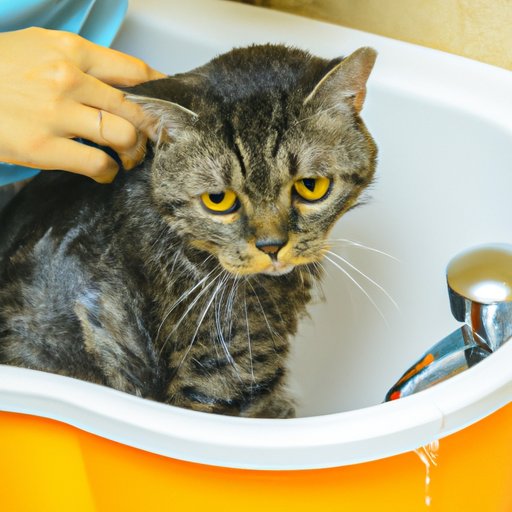Introduction
Bathing a cat is not always an easy task. Many cats are not fond of water, which can make it difficult to give them a bath. However, regular baths are important for your cat’s hygiene and health. This article will provide a step-by-step guide to help you successfully bathe your cat, as well as product recommendations and tips for avoiding common mistakes.
Step-by-Step Guide
Before you start, make sure you have all of the necessary supplies on hand. You’ll need a cat-specific shampoo, a cup or pitcher for rinsing, a towel, and a hair dryer (optional). It’s also a good idea to trim your cat’s nails and brush their coat to remove any tangles before getting started.
Fill the bathtub with warm water that reaches your cat’s belly. Make sure the water is not too hot, or it may burn your cat’s skin. Wet your cat’s coat thoroughly with the water, avoiding the head.
Apply your cat shampoo, starting at the neck and working your way down to the tail. Massage the shampoo gently into your cat’s coat, being extra careful around their face and ears.
Once the shampoo has been applied, rinse your cat thoroughly with the cup or pitcher until all of the suds are gone. You may want to repeat the shampooing and rinsing process if your cat is particularly dirty or smelly. If desired, you can also apply a cat-specific conditioner at this point and repeat the rinsing process.
Finally, dry your cat off with a towel or blow dryer. If using a blow dryer, make sure to use the lowest possible heat setting and keep it several inches away from your cat’s skin to avoid burning or overheating. Once your cat is dry, reward them with a treat or some extra cuddles for being a good sport.
Product Recommendations
When choosing a cat shampoo, look for a product that is specifically formulated for cats and free of harsh chemicals or fragrances. Some good options include oatmeal-based shampoos, tearless shampoos, and waterless shampoos.
If your cat has sensitive skin, consider switching to a natural or hypoallergenic shampoo. Aloe vera, chamomile, and coconut oil are all gentle ingredients that can soothe and moisturize your cat’s skin.
If you decide to use a conditioner, choose a product that is made specifically for cats. Conditioners can help to detangle and soften your cat’s coat while also moisturizing their skin.
Health Benefits
Regular baths can help to prevent skin-related issues such as dandruff, fungal infections, and hot spots. They can also reduce the risk of ticks and fleas, which can lead to diseases like Lyme disease and tapeworms.
In addition, bathing your cat regularly can help to keep their coat and skin healthy and reduce shedding. It also provides an opportunity for you to check for any lumps, bumps, or other signs of illness.
Avoiding Common Mistakes
One of the most common mistakes people make when bathing their cats is using the wrong shampoo. Never use human shampoo or dish soap, as these products can be too harsh for your cat’s delicate skin.
Another common mistake is not rinsing your cat thoroughly enough. Make sure to use plenty of water to rinse off all of the shampoo and avoid leaving any residue on your cat’s coat.
Shortcuts for Easier Baths
If your cat really hates water, you may want to try using a dry shampoo instead. Dry shampoos come in powder or spray form and can be applied directly to your cat’s coat. They are a great option for cats who don’t tolerate wet baths.
Grooming wipes are another handy tool to have on hand. They can quickly and easily clean your cat’s coat without the need for water or shampoo. Look for wipes that are specifically formulated for cats and free of harsh chemicals.
Q&A Style
Q: How often should I bathe my cat?
A: It depends on your cat’s individual needs. Most cats do not need to be bathed more than once every few months. If your cat is particularly dirty or smelly, you may need to bathe them more often.
Q: What should I do if my cat resists bathing?
A: Try to make the experience as comfortable and stress-free as possible for your cat. Use a gentle, soothing tone of voice and be patient. You may also want to try a non-slip mat in the bathtub to help your cat feel more secure.
Q: Can’t cats clean themselves well enough?
A: While cats are known for their grooming skills, regular baths can still be beneficial for their hygiene and health. Plus, it gives you a chance to check for any potential health issues.
Conclusion
Bathing your cat may be a challenge, but it’s an essential part of their grooming and hygiene routine. By following the steps outlined in this article and using the recommended products and tips, you can help your cat stay healthy and clean. Don’t be afraid to experiment with different techniques and products to find what works best for your cat.
